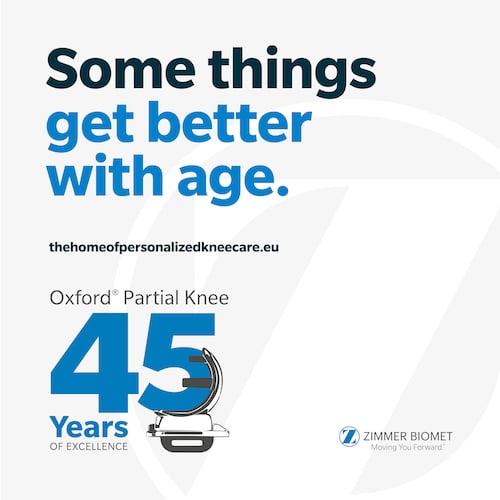This randomized single-blinded study compared survivorship, clinical outcomes, and radiographs of cementless tibial components with those of cemented tibial components of a matched design at a mean follow-up of 13.2 years (11 to 15 years).1
Both components provided excellent survivorship at 15 years – with just one revision following a fall resulting in a peri-prosthetic fracture in the cementless group.1
There were no preoperative differences in demographic or outcome scores between the groups. Neither were there any differences in Oxford Knee Score (OKS) or Knee Society Score (KSS) at one-, three- or five-year follow-ups.1
However, at the final follow-up, statistically significant differences were reported for both the OKS (p = 0.001) and the KSS (p < 0.001).1
At this time point, the median OKS was 44 (IQR 41 to 45) in the cementless group and 37 (IQR 28.5 to 44) in the cemented group, while the KSS was 96 (IQR 92 to 100) in the cementless group compared to 86 (IQR 74 to 93.5) in the cemented group. 1
According to the literature the minimal clinically important difference for the OKS is 5 points and for the KSS it is 6.1 points. This means that as well as being statistically significant, these results are also clinically significant. 2, 3
The authors noted that the cementless group maintained their median OKS and KSS at each interval whereas the same scores for the cemented group gradually decreased over time, with the difference becoming significant at the final follow-up (at minimum 11 years). 1
They hypothesised that the divergence in scores “results from a gradual mechanical loosening of the cemented tibial component over time. This loosening may be minor initially, but eventually leads to micromotion of the tibial component. This proposed mechanism is supported by the observation of progressive development of radiolucent lines beneath the tibial tray. These were more frequently recorded in the cemented group and increased over time. Radiolucent lines were not seen in the cementless group, possibly reflecting a stronger biological bone-implant interface which remains well fixed, reduces stress shielding, or a combination of both factors.” 1
The authors acknowledged that there currently appears to be no correlation between the rates of patient satisfaction and the rates of revision; but as the most common reason for revision is aseptic loosening, they believe that it is reasonable to assume that this mode of failure contributes to patient dissatisfaction. 1 They therefore propose that “approaches reducing the risk of aseptic loosening can improve patient satisfaction and use of cementless tibial component may be one way of achieving this.” 1
A post-hoc sub-group analysis was used to compare the results of patients aged under 60 years with those aged over 60 years at the time of surgery. This analysis revealed no significant differences in any of the outcome scores between the two age groups. 1 The authors concluded that cementless tibial components may offer an advantage in patients with a life expectancy of more than 11 years. 1

